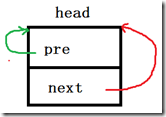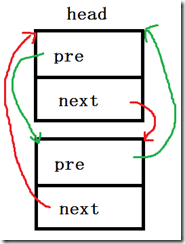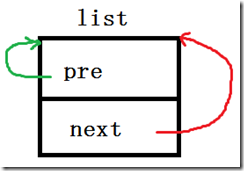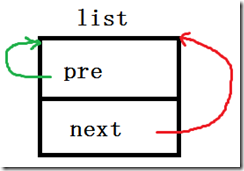stddef.h
#define offsetof(TYPE, MEMBER) ((size_t) &((TYPE *)0)->MEMBER)
list.h
#ifndef _LINUX_LIST_H
#define _LINUX_LIST_H
#include <linux/stddef.h>
#include <linux/poison.h>
#include <linux/prefetch.h>
#include <asm/system.h>
/*
* Simple doubly linked list implementation.
*
* Some of the internal functions ("__xxx") are useful when
* manipulating whole lists rather than single entries, as
* sometimes we already know the next/prev entries and we can
* generate better code by using them directly rather than
* using the generic single-entry routines.
*/
struct list_head {
struct list_head *next, *prev;
};
#define LIST_HEAD_INIT(name) { &(name), &(name) }
示例:
struct fox red_fox = {
.tail_length = 40,
.weight = 6,
.list = LIST_HEAD_INIT(red_fox.list);
};
#define LIST_HEAD(name)
struct list_head name = LIST_HEAD_INIT(name)
示例:
LIST_HEAD(head);
static inline void INIT_LIST_HEAD(struct list_head *list)
{
list->next = list;
list->prev = list;
}
示例:
1: struct fox{
2: unsigned long tail_length;
3: unsigned long weight;
4: bool is_fantastic;
5: struct list_head list;
6: };
7:
8:
9: struct fox *red_fox;
10: red_fox = kmalloc(sizeof(*red_fox), GFP_KERNEL);
11: red_fox->tail_length = 40;
12: red_fox->weight = 6;
13: red_fox->is_fantastic = false;
14: INIT_LIST_HEAD(&red_fox->list);
/*
* Insert a new entry between two known consecutive entries.
*
* This is only for internal list manipulation where we know
* the prev/next entries already!
*/
#ifndef CONFIG_DEBUG_LIST
将new查到prev和next中间
static inline void __list_add(struct list_head *new,
struct list_head *prev,
struct list_head *next)
{
next->prev = new;
new->next = next;
new->prev = prev;
prev->next = new;
}
#else
extern void __list_add(struct list_head *new,
struct list_head *prev,
struct list_head *next);
#endif
/**
* list_add - add a new entry
* @new: new entry to be added
* @head: list head to add it after
*
* Insert a new entry after the specified head.
* This is good for implementing stacks.
*/
将new插入的head后面。
static inline void list_add(struct list_head *new, struct list_head *head)
{
__list_add(new, head, head->next);
}
/**
* list_add_tail - add a new entry
* @new: new entry to be added
* @head: list head to add it before
*
* Insert a new entry before the specified head.
* This is useful for implementing queues.
*/
将new插入到head前面
static inline void list_add_tail(struct list_head *new, struct list_head *head)
{
__list_add(new, head->prev, head);
}
/*
* Delete a list entry by making the prev/next entries
* point to each other.
*
* This is only for internal list manipulation where we know
* the prev/next entries already!
*/
删除prev和next中间的结点
static inline void __list_del(struct list_head * prev, struct list_head * next)
{
next->prev = prev;
prev->next = next;
}
/**
* list_del - deletes entry from list.
* @entry: the element to delete from the list.
* Note: list_empty() on entry does not return true after this, the entry is
* in an undefined state.
*/
从链表中删除entry所在的结点,不释放entry的空间
#define LIST_POISON1 ((void *) 0x00100100)
#define LIST_POISON2 ((void *) 0x00200200)
#ifndef CONFIG_DEBUG_LIST
static inline void list_del(struct list_head *entry)
{
__list_del(entry->prev, entry->next);
entry->next = LIST_POISON1;
entry->prev = LIST_POISON2;
}
#else
extern void list_del(struct list_head *entry);
#endif
/**
* list_replace - replace old entry by new one
* @old : the element to be replaced
* @new : the new element to insert
*
* If @old was empty, it will be overwritten.
*/
将old替换为new
static inline void list_replace(struct list_head *old,
struct list_head *new)
{
new->next = old->next;
new->next->prev = new;
new->prev = old->prev;
new->prev->next = new;
}
将old替换为new,并且将old重新初始化
static inline void list_replace_init(struct list_head *old,
struct list_head *new)
{
list_replace(old, new);
INIT_LIST_HEAD(old);
}
/**
* list_del_init - deletes entry from list and reinitialize it.
* @entry: the element to delete from the list.
*/
从链表中删除entry,并且将entry重新初始化
static inline void list_del_init(struct list_head *entry)
{
__list_del(entry->prev, entry->next);
INIT_LIST_HEAD(entry);
}
/**
* list_move - delete from one list and add as another's head
* @list: the entry to move
* @head: the head that will precede our entry
*/
将list从原来的链表移动到head链表中
static inline void list_move(struct list_head *list, struct list_head *head)
{
__list_del(list->prev, list->next);
list_add(list, head);
}
/**
* list_move_tail - delete from one list and add as another's tail
* @list: the entry to move
* @head: the head that will follow our entry
*/
将list从原先的链表中删除,添加到head链表中(并且查到head的前边)
static inline void list_move_tail(struct list_head *list,
struct list_head *head)
{
__list_del(list->prev, list->next);
list_add_tail(list, head);
}
/**
* list_is_last - tests whether @list is the last entry in list @head
* @list: the entry to test
* @head: the head of the list
*/
判断list是不是链表head的尾结点
static inline int list_is_last(const struct list_head *list,
const struct list_head *head)
{
return list->next == head;
}
/**
* list_empty - tests whether a list is empty
* @head: the list to test.
*/

static inline int list_empty(const struct list_head *head)
{
return head->next == head;
}
/**
* list_empty_careful - tests whether a list is empty and not being modified
* @head: the list to test
*
* Description:
* tests whether a list is empty _and_ checks that no other CPU might be
* in the process of modifying either member (next or prev)
*
* NOTE: using list_empty_careful() without synchronization
* can only be safe if the only activity that can happen
* to the list entry is list_del_init(). Eg. it cannot be used
* if another CPU could re-list_add() it.
*/

static inline int list_empty_careful(const struct list_head *head)
{
struct list_head *next = head->next;
return (next == head) && (next == head->prev);
}
/**
* list_is_singular - tests whether a list has just one entry.
* @head: the list to test.
*/

static inline int list_is_singular(const struct list_head *head)
{
return !list_empty(head) && (head->next == head->prev);
}
static inline void __list_cut_position(struct list_head *list,
struct list_head *head, struct list_head *entry)
{
struct list_head *new_first = entry->next;
list->next = head->next;
list->next->prev = list;
list->prev = entry;
entry->next = list;
head->next = new_first;
new_first->prev = head;
}
/**
* list_cut_position - cut a list into two
* @list: a new list to add all removed entries
* @head: a list with entries
* @entry: an entry within head, could be the head itself
* and if so we won't cut the list
*
* This helper moves the initial part of @head, up to and
* including @entry, from @head to @list. You should
* pass on @entry an element you know is on @head. @list
* should be an empty list or a list you do not care about
* losing its data.
*
*/
static inline void list_cut_position(struct list_head *list,
struct list_head *head, struct list_head *entry)
{
if (list_empty(head))
return;
if (list_is_singular(head) &&
(head->next != entry && head != entry))
return;
if (entry == head)
INIT_LIST_HEAD(list);
else
__list_cut_position(list, head, entry);
}
static inline void __list_splice(const struct list_head *list,
struct list_head *prev,
struct list_head *next)
{
struct list_head *first = list->next;
struct list_head *last = list->prev;
first->prev = prev;
prev->next = first;
last->next = next;
next->prev = last;
}
/**
* list_splice - join two lists, this is designed for stacks
* @list: the new list to add.
* @head: the place to add it in the first list.
*/
将链表list中除了结点list在外(去头)的剩余的结点加入到head链表后面。
static inline void list_splice(const struct list_head *list,
struct list_head *head)
{
if (!list_empty(list))
__list_splice(list, head, head->next);
}
/**
* list_splice_tail - join two lists, each list being a queue
* @list: the new list to add.
* @head: the place to add it in the first list.
*/

static inline void list_splice_tail(struct list_head *list,
struct list_head *head)
{
if (!list_empty(list))
__list_splice(list, head->prev, head);
}
/**
* list_splice_init - join two lists and reinitialise the emptied list.
* @list: the new list to add.
* @head: the place to add it in the first list.
*
* The list at @list is reinitialised
*/
同时将list重新初始化,
static inline void list_splice_init(struct list_head *list,
struct list_head *head)
{
if (!list_empty(list)) {
__list_splice(list, head, head->next);
INIT_LIST_HEAD(list);
}
}
/**
* list_splice_tail_init - join two lists and reinitialise the emptied list
* @list: the new list to add.
* @head: the place to add it in the first list.
*
* Each of the lists is a queue.
* The list at @list is reinitialised
*/
同时将list重新初始化,

static inline void list_splice_tail_init(struct list_head *list,
struct list_head *head)
{
if (!list_empty(list)) {
__list_splice(list, head->prev, head);
INIT_LIST_HEAD(list);
}
}
/**
* container_of - cast a member of a structure out to the containing structure
* @ptr: the pointer to the member.
* @type: the type of the container struct this is embedded in.
* @member: the name of the member within the struct.
*
*/
#define container_of(ptr, type, member) ({
const typeof( ((type *)0)->member ) *__mptr = (ptr);
(type *)( (char *)__mptr - offsetof(type,member) );})
/**
* list_entry - get the struct for this entry
* @ptr: the &struct list_head pointer.
* @type: the type of the struct this is embedded in.
* @member: the name of the list_struct within the struct.
*/
#define list_entry(ptr, type, member)
container_of(ptr, type, member)
/**
* list_first_entry - get the first element from a list
* @ptr: the list head to take the element from.
* @type: the type of the struct this is embedded in.
* @member: the name of the list_struct within the struct.
*
* Note, that list is expected to be not empty.
*/
#define list_first_entry(ptr, type, member)
list_entry((ptr)->next, type, member)
/**
* list_for_each - iterate over a list
* @pos: the &struct list_head to use as a loop cursor.
* @head: the head for your list.
*/
prefetch的使用可以参考:
http://www.cnblogs.com/pengdonglin137/p/3716883.html
http://www.cnblogs.com/pengdonglin137/p/3716889.html
#define list_for_each(pos, head)
for (pos = (head)->next; prefetch(pos->next), pos != (head);
pos = pos->next)
1: struct fox{
2: unsigned long tail_length;
3: unsigned long weight;
4: bool is_fantastic;
5: struct list_head list;
6: };
7:
8: struct fox a;
9: struct list_head *p = NULL;
10: struct list_head *q = NULL;
11:
12: ......
13: 假设a是头结点
14:
15: q = &(a.list);
16:
17: list_for_each(p, q)
18: {
19: ......// 使用指针p完成一些操作
20: }
/**
* __list_for_each - iterate over a list
* @pos: the &struct list_head to use as a loop cursor.
* @head: the head for your list.
*
* This variant differs from list_for_each() in that it's the
* simplest possible list iteration code, no prefetching is done.
* Use this for code that knows the list to be very short (empty
* or 1 entry) most of the time.
*/
正向遍历head链表,在循环中不能释放pos指向的结点所在的空间
#define __list_for_each(pos, head)
for (pos = (head)->next; pos != (head); pos = pos->next)
示例:
1: struct fox{
2: unsigned long tail_length;
3: unsigned long weight;
4: bool is_fantastic;
5: struct list_head list;
6: };
7:
8: struct fox a;
9: struct list_head *p = NULL;
10: struct list_head *q = NULL;
11:
12: ......
13: 假设a是头结点
14:
15: q = &(a.list);
16:
17: __list_for_each(p, q)
18: {
19: ......// 使用指针p完成一些操作
20: }
/**
* list_for_each_prev - iterate over a list backwards
* @pos: the &struct list_head to use as a loop cursor.
* @head: the head for your list.
*/
反向遍历head链表,再循环中不能释放pos指向的结点所在的空间
#define list_for_each_prev(pos, head)
for (pos = (head)->prev; prefetch(pos->prev), pos != (head);
pos = pos->prev)
示例:
1: struct fox{
2: unsigned long tail_length;
3: unsigned long weight;
4: bool is_fantastic;
5: struct list_head list;
6: };
7:
8: struct fox a;
9: struct list_head *p = NULL;
10: struct list_head *q = NULL;
11:
12: ......
13: 假设a是头结点
14:
15: q = &(a.list);
16:
17: list_for_each_prev(p, q)
18: {
19: ......// 使用指针p完成一些操作,但是不要释放p指向的结点所站的空间
20: }
/**
* list_for_each_safe - iterate over a list safe against removal of list entry
* @pos: the &struct list_head to use as a loop cursor.
* @n: another &struct list_head to use as temporary storage
* @head: the head for your list.
*/
正向遍历head链表,跟list_for_each不同之处是,可以在循环中释放pos指向的结点
#define list_for_each_safe(pos, n, head)
for (pos = (head)->next, n = pos->next; pos != (head);
pos = n, n = pos->next)
示例:
1: struct fox{
2: unsigned long tail_length;
3: unsigned long weight;
4: bool is_fantastic;
5: struct list_head list;
6: };
7:
8: struct fox a;
9: struct list_head *p = NULL;
10: struct list_head *q = NULL;
11:
12: ......
13: 假设a是头结点
14:
15: q = &(a.list);
16:
17: struct list_head *n = NULL;
18:
19: list_for_each_safe(p, n, q)
20: {
21: ......// 使用指针p完成一些操作,可以删除p指向的结点所在的空间
22: }
/**
* list_for_each_prev_safe - iterate over a list backwards safe against removal of list entry
* @pos: the &struct list_head to use as a loop cursor.
* @n: another &struct list_head to use as temporary storage
* @head: the head for your list.
*/
反向遍历head链表,跟list_for_each_prev不同之处是,可以在循环中释放pos指向的结点
#define list_for_each_prev_safe(pos, n, head)
for (pos = (head)->prev, n = pos->prev;
prefetch(pos->prev), pos != (head);
pos = n, n = pos->prev)
示例:
1: struct fox{
2: unsigned long tail_length;
3: unsigned long weight;
4: bool is_fantastic;
5: struct list_head list;
6: };
7:
8: struct fox a;
9: struct list_head *p = NULL;
10: struct list_head *q = NULL;
11:
12: ......
13: 假设a是头结点
14:
15: q = &(a.list);
16:
17: struct list_head *n = NULL;
18:
19: list_for_each_prev_safe(p, n, q)
20: {
21: ......// 使用指针p完成一些操作,可以删除p指向的结点所在的空间
22: }
/**
* list_for_each_entry - iterate over list of given type
* @pos: the type * to use as a loop cursor.
* @head: the head for your list.
* @member: the name of the list_struct within the struct.
*/
正向遍历head链表,与list_for_each不同之处是,pos指向的可以不是struct list_head类型的结构体,而是含有struct
list_head类型结构体的结构体。
#define list_for_each_entry(pos, head, member)
for (pos = list_entry((head)->next, typeof(*pos), member);
prefetch(pos->member.next), &pos->member != (head);
pos = list_entry(pos->member.next, typeof(*pos), member))
示例:
1: struct fox{
2: unsigned long tail_length;
3: unsigned long weight;
4: bool is_fantastic;
5: struct list_headlist
;
6: };
7:
8: struct fox a;
9: struct fox *p = NULL;
10: struct head_list *q = NULL;
11: ......
12: 假设a是头结点
13:
14: q = &(a.list);
15:
16: list_for_each_entry(p, q,
list
) // 其中list是struct fox中struct list_head类型的成员变量名
17: {
18: ......// 使用指针p完成一些操作,不可以释放p指向的结点所在的空间
19: }
/**
* list_for_each_entry_reverse - iterate backwards over list of given type.
* @pos: the type * to use as a loop cursor.
* @head: the head for your list.
* @member: the name of the list_struct within the struct.
*/
正向遍历head链表,与list_for_each_prev不同之处是,pos指向的可以不是struct list_head类型的结构体,而是含有struct list_head类型结构体的结构体。
#define list_for_each_entry_reverse(pos, head, member)
for (pos = list_entry((head)->prev, typeof(*pos), member);
prefetch(pos->member.prev), &pos->member != (head);
pos = list_entry(pos->member.prev, typeof(*pos), member))
示例:
1: struct fox{
2: unsigned long tail_length;
3: unsigned long weight;
4: bool is_fantastic;
5: struct list_head list;
6: };
7:
8: struct fox a;
9: struct fox *p = NULL;
10: struct head_list *q = NULL;
11: ......
12: 假设a是头结点
13:
14: q = &(a.list);
15:
16: list_for_each_entry_reverse(p, q, list) // 其中list是struct fox中struct list_head类型的成员变量名
17: {
18: ......// 使用指针p完成一些操作,不可以释放p指向的结点所在的空间
19: }
/**
* list_prepare_entry - prepare a pos entry for use in list_for_each_entry_continue()
* @pos: the type * to use as a start point
* @head: the head of the list
* @member: the name of the list_struct within the struct.
*
* Prepares a pos entry for use as a start point in list_for_each_entry_continue().
*/
#define list_prepare_entry(pos, head, member)
((pos) ? : list_entry(head, typeof(*pos), member))
/**
* list_for_each_entry_continue - continue iteration over list of given type
* @pos: the type * to use as a loop cursor.
* @head: the head for your list.
* @member: the name of the list_struct within the struct.
*
* Continue to iterate over list of given type, continuing after
* the current position.
*/
#define list_for_each_entry_continue(pos, head, member)
for (pos = list_entry(pos->member.next, typeof(*pos), member);
prefetch(pos->member.next), &pos->member != (head);
pos = list_entry(pos->member.next, typeof(*pos), member))
/**
* list_for_each_entry_continue_reverse - iterate backwards from the given point
* @pos: the type * to use as a loop cursor.
* @head: the head for your list.
* @member: the name of the list_struct within the struct.
*
* Start to iterate over list of given type backwards, continuing after
* the current position.
*/
#define list_for_each_entry_continue_reverse(pos, head, member)
for (pos = list_entry(pos->member.prev, typeof(*pos), member);
prefetch(pos->member.prev), &pos->member != (head);
pos = list_entry(pos->member.prev, typeof(*pos), member))
/**
* list_for_each_entry_from - iterate over list of given type from the current point
* @pos: the type * to use as a loop cursor.
* @head: the head for your list.
* @member: the name of the list_struct within the struct.
*
* Iterate over list of given type, continuing from current position.
*/
#define list_for_each_entry_from(pos, head, member)
for (; prefetch(pos->member.next), &pos->member != (head);
pos = list_entry(pos->member.next, typeof(*pos), member))
/**
* list_for_each_entry_safe - iterate over list of given type safe against removal of list entry
* @pos: the type * to use as a loop cursor.
* @n: another type * to use as temporary storage
* @head: the head for your list.
* @member: the name of the list_struct within the struct.
*/
#define list_for_each_entry_safe(pos, n, head, member)
for (pos = list_entry((head)->next, typeof(*pos), member),
n = list_entry(pos->member.next, typeof(*pos), member);
&pos->member != (head);
pos = n, n = list_entry(n->member.next, typeof(*n), member))
/**
* list_for_each_entry_safe_continue
* @pos: the type * to use as a loop cursor.
* @n: another type * to use as temporary storage
* @head: the head for your list.
* @member: the name of the list_struct within the struct.
*
* Iterate over list of given type, continuing after current point,
* safe against removal of list entry.
*/
#define list_for_each_entry_safe_continue(pos, n, head, member)
for (pos = list_entry(pos->member.next, typeof(*pos), member),
n = list_entry(pos->member.next, typeof(*pos), member);
&pos->member != (head);
pos = n, n = list_entry(n->member.next, typeof(*n), member))
/**
* list_for_each_entry_safe_from
* @pos: the type * to use as a loop cursor.
* @n: another type * to use as temporary storage
* @head: the head for your list.
* @member: the name of the list_struct within the struct.
*
* Iterate over list of given type from current point, safe against
* removal of list entry.
*/
#define list_for_each_entry_safe_from(pos, n, head, member)
for (n = list_entry(pos->member.next, typeof(*pos), member);
&pos->member != (head);
pos = n, n = list_entry(n->member.next, typeof(*n), member))
/**
* list_for_each_entry_safe_reverse
* @pos: the type * to use as a loop cursor.
* @n: another type * to use as temporary storage
* @head: the head for your list.
* @member: the name of the list_struct within the struct.
*
* Iterate backwards over list of given type, safe against removal
* of list entry.
*/
#define list_for_each_entry_safe_reverse(pos, n, head, member)
for (pos = list_entry((head)->prev, typeof(*pos), member),
n = list_entry(pos->member.prev, typeof(*pos), member);
&pos->member != (head);
pos = n, n = list_entry(n->member.prev, typeof(*n), member))
/*
* Double linked lists with a single pointer list head.
* Mostly useful for hash tables where the two pointer list head is
* too wasteful.
* You lose the ability to access the tail in O(1).
*/
struct hlist_head {
struct hlist_node *first;
};
struct hlist_node {
struct hlist_node *next, **pprev;
};
#define HLIST_HEAD_INIT { .first = NULL }
#define HLIST_HEAD(name) struct hlist_head name = { .first = NULL }
#define INIT_HLIST_HEAD(ptr) ((ptr)->first = NULL)
static inline void INIT_HLIST_NODE(struct hlist_node *h)
{
h->next = NULL;
h->pprev = NULL;
}
static inline int hlist_unhashed(const struct hlist_node *h)
{
return !h->pprev;
}
static inline int hlist_empty(const struct hlist_head *h)
{
return !h->first;
}
static inline void __hlist_del(struct hlist_node *n)
{
struct hlist_node *next = n->next;
struct hlist_node **pprev = n->pprev;
*pprev = next;
if (next)
next->pprev = pprev;
}
static inline void hlist_del(struct hlist_node *n)
{
__hlist_del(n);
n->next = LIST_POISON1;
n->pprev = LIST_POISON2;
}
static inline void hlist_del_init(struct hlist_node *n)
{
if (!hlist_unhashed(n)) {
__hlist_del(n);
INIT_HLIST_NODE(n);
}
}
static inline void hlist_add_head(struct hlist_node *n, struct hlist_head *h)
{
struct hlist_node *first = h->first;
n->next = first;
if (first)
first->pprev = &n->next;
h->first = n;
n->pprev = &h->first;
}
/* next must be != NULL */
static inline void hlist_add_before(struct hlist_node *n,
struct hlist_node *next)
{
n->pprev = next->pprev;
n->next = next;
next->pprev = &n->next;
*(n->pprev) = n;
}
static inline void hlist_add_after(struct hlist_node *n,
struct hlist_node *next)
{
next->next = n->next;
n->next = next;
next->pprev = &n->next;
if(next->next)
next->next->pprev = &next->next;
}
/*
* Move a list from one list head to another. Fixup the pprev
* reference of the first entry if it exists.
*/
static inline void hlist_move_list(struct hlist_head *old,
struct hlist_head *new)
{
new->first = old->first;
if (new->first)
new->first->pprev = &new->first;
old->first = NULL;
}
#define hlist_entry(ptr, type, member) container_of(ptr,type,member)
#define hlist_for_each(pos, head)
for (pos = (head)->first; pos && ({ prefetch(pos->next); 1; });
pos = pos->next)
#define hlist_for_each_safe(pos, n, head)
for (pos = (head)->first; pos && ({ n = pos->next; 1; });
pos = n)
/**
* hlist_for_each_entry - iterate over list of given type
* @tpos: the type * to use as a loop cursor.
* @pos: the &struct hlist_node to use as a loop cursor.
* @head: the head for your list.
* @member: the name of the hlist_node within the struct.
*/
#define hlist_for_each_entry(tpos, pos, head, member)
for (pos = (head)->first;
pos && ({ prefetch(pos->next); 1;}) &&
({ tpos = hlist_entry(pos, typeof(*tpos), member); 1;});
pos = pos->next)
/**
* hlist_for_each_entry_continue - iterate over a hlist continuing after current point
* @tpos: the type * to use as a loop cursor.
* @pos: the &struct hlist_node to use as a loop cursor.
* @member: the name of the hlist_node within the struct.
*/
#define hlist_for_each_entry_continue(tpos, pos, member)
for (pos = (pos)->next;
pos && ({ prefetch(pos->next); 1;}) &&
({ tpos = hlist_entry(pos, typeof(*tpos), member); 1;});
pos = pos->next)
/**
* hlist_for_each_entry_from - iterate over a hlist continuing from current point
* @tpos: the type * to use as a loop cursor.
* @pos: the &struct hlist_node to use as a loop cursor.
* @member: the name of the hlist_node within the struct.
*/
#define hlist_for_each_entry_from(tpos, pos, member)
for (; pos && ({ prefetch(pos->next); 1;}) &&
({ tpos = hlist_entry(pos, typeof(*tpos), member); 1;});
pos = pos->next)
/**
* hlist_for_each_entry_safe - iterate over list of given type safe against removal of list entry
* @tpos: the type * to use as a loop cursor.
* @pos: the &struct hlist_node to use as a loop cursor.
* @n: another &struct hlist_node to use as temporary storage
* @head: the head for your list.
* @member: the name of the hlist_node within the struct.
*/
#define hlist_for_each_entry_safe(tpos, pos, n, head, member)
for (pos = (head)->first;
pos && ({ n = pos->next; 1; }) &&
({ tpos = hlist_entry(pos, typeof(*tpos), member); 1;});
pos = n)
#endif









